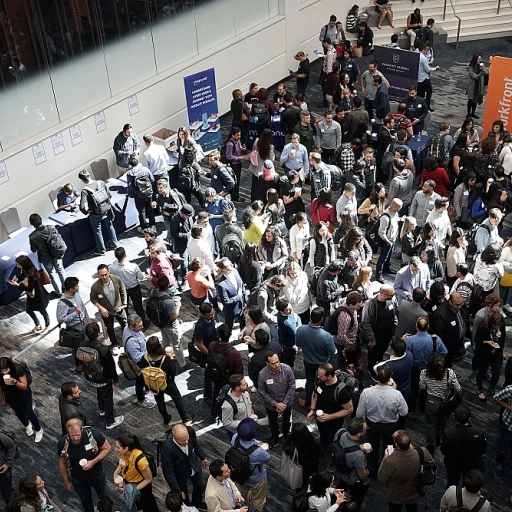
Understanding the Appeal of Dream Center Jobs
The Intriguing Factors Driving Appeal in Dream Center Jobs
Working at agencies like the Dream Center, particularly in vibrant cities such as Los Angeles or Phoenix, carries immense appeal for professionals passionate about fostering community growth. These roles often revolve around supporting programs that significantly impact youth, including foster youth, undocumented students, and mixed status families. Such an environment provides a unique opportunity for employees to align their personal values with their job responsibilities, fostering a deep sense of fulfillment. Dream Center Jobs entice individuals who thrive in roles offering direct community engagement. Positions often include job descriptions centered around youth support services, transitional housing, or dealing with sensitive areas like human trafficking. These roles do not only require professionals who have skills in case management and job coordination but also a genuine eagerness to contribute to community welfare and developmental programs. Moreover, the Dream Center's initiatives, such as the adopt block program or community volunteer efforts, highlight an institution's commitment to offer tangible help. Employees in such organizations are not merely performing tasks; they are carrying out work that could be transformational for entire communities. This intrinsic motivation, intertwined with a clear purpose, often leads to higher job satisfaction and retention rates. For companies seeking to bolster their employee retention, fostering a workspace that mirrors Dream Center's attraction factors can be transformative. Offering clear career development opportunities, maintaining a supportive workplace culture, and ensuring recognition systems reflect genuine care for employees are key aspects companies can adopt. To deeply understand how these appealing aspects of Dream Center Jobs contribute to longer employee tenures and explore how workplace behavior impacts retention, explore this resource.The Role of Workplace Culture in Retention
Creating a Supportive and Inclusive Environment
When it comes to employee retention, one cannot ignore the significance of workplace culture. A supportive work culture, especially in dream center jobs, is pivotal in ensuring staff members remain engaged and committed. By fostering an environment where employees feel valued and respected, organizations can significantly reduce turnover rates. This is true for centers in bustling cities like Los Angeles and Phoenix, where diverse communities congregate.
A strong emphasis on inclusivity can help in retaining a wide array of talent, including full-time employees, community volunteers, and even part-time staff or students involved in programs specifically designed for youth and foster youth. It's important for these facilities to understand that their workforce often includes undocumented students, mixed status families, and foster youth, all of whom require unique support structures.
Dream centers are often more than just workplaces. They are community hubs that offer transitional housing, recovery programs, and case management services. By creating a sense of community, these centers encourage staff to stay long term. A positive culture supports those who might otherwise feel marginalized, thus increasing job satisfaction and retention.
Moreover, it's essential to recognize the impact of adopting a block-like mentoring approach. Experienced employees can guide newer ones, creating a cycle of learning and support. This is not only crucial for employee satisfaction but also aids in providing consistent, quality services to those in need. Referencing a "supportive work culture" can further provide insights into building effective teamwork and communication.
Ultimately, investing in workplace culture is a strategic step towards enhancing employee retention. It is about creating a nurturing environment that supports the dreams and aspirations of the staff while fulfilling the organizational goals of service and care, aligning with the mission of dream centers across cities like Los Angeles and others.
Effective Communication Strategies
Crafting Effective Communication within the Dream Center Environment
Effective communication is paramount in building a nurturing environment where employees in dream center jobs feel valued and engaged. The hallmark of a supportive workplace, particularly in organizations like the Los Angeles Dream Center, with its diverse programs ranging from transitional housing to services for foster youth, lies in open dialogue and transparent channels. Clear and consistent communication fosters a sense of trust and belonging. When employees, from case management teams to community volunteers, are fully informed and involved, they're more likely to remain committed. Promoting an open-door policy where team members can freely express concerns and ideas can significantly enhance morale and productivity. Additionally, communication strategies should be inclusive of everyone in the community, from undocumented students to full-time staff. Tailoring communication to address the unique needs of these groups ensures everyone is heard and supported. For instance, regular updates on job description changes or program shifts can mitigate misunderstandings, enhancing overall satisfaction. In today’s dynamic job market, the importance of communications transcends traditional roles, especially within resource centers. Establishing mechanisms for feedback can help directors and leaders in dream centers improve approaches, adapt services, and ultimately, propel retention success. Furthermore, exploring platforms and tools for seamless internal communication ensures that support is timely and effective. Understanding New Jersey's at-will employment status enhances one's approach to employment relationships, where communication becomes a pivotal aspect of sustaining long-term employment relationships. In essence, effective communication is the backbone of strong employee retention in dream centers, supporting both the mission and the community it serves.Career Development Opportunities
Pathways to Professional Growth
In exploring the realm of dream jobs at centers, offering robust career development opportunities emerges as a pivotal factor for employee retention. It's not merely enough to appreciate the initial appeal or supportive workplace culture, fostering long-term engagement mandates clear growth avenues. This is especially important when catering to diverse groups within dream centers, such as foster youth and students. Providing career advancement programs tailored to the needs of the workforce contributes significantly to retention. Organizations can initiate mentorship programs that pair seasoned directors with younger employees, helping them to navigate their career paths and reach their full potential. Meanwhile, developing personalized training workshops can address the specific skills needed for various roles like case management or human trafficking recovery program coordinators. Moreover, facilitating access to certifications and continued education grants both support and legitimizes employees' efforts towards achieving professional goals. In community-driven environments, incorporating community volunteer opportunities can help employees gain experiences that are vital to their personal and professional growth. The provision of these resources and opportunities does not only retain current talent but also positions dream centers like those in Los Angeles Dream Center or Phoenix as attractive employers for future candidates. When job descriptions prominently include pathways for advancement and highlight support for a balanced life, potential employees perceive these organizations as places where they can envisage long-term careers. Furthermore, to handle specific cases like undocumented students or those from mixed status families, skillful program initiatives can ensure employees are well-prepared to offer the best possible services. Employee retention is intricately tied to the growth opportunities available within the organization. When employees see a future within their current role, enhanced by educational and experiential supports, such opportunities are bound to nurture loyalty and long-term commitment to the organization.Balancing Work-Life Integration
Achieving Harmony in Work-Life Fusion
Striking a balance between professional responsibilities and personal life is a critical element in maintaining employee satisfaction and retention at Dream Center Jobs. With the increasing demand for flexibility, particularly among communities like foster youth and undocumented students who engage in transitional housing and other supportive services, it is essential for organizations to accommodate their unique needs.
A flexible work schedule can be especially beneficial, allowing staff to manage their time effectively while attending to personal obligations. This approach fosters a supportive environment, enabling employees to be more engaged and less stressed. Moreover, jobs that offer remote work options or customized work hours can significantly enhance job satisfaction, particularly in fast-paced environments found in bustling cities like Los Angeles and Phoenix.
For those involved in intensive roles such as case management or recovery programs, ensuring work-life harmony becomes even more critical. Programs that provide full-time roles need to consider how elements such as mental health resources and community volunteer opportunities can integrate into broader employee wellness initiatives.
Furthermore, the presence of a comprehensive privacy policy assures mixed status families and other sensitive-status employees of a commitment to confidentiality, making them feel secure and respected. Youth and student workers, under the guidance of dynamic directors at dream centers, benefit greatly when their jobs are designed to support their growth while aligning with personal life priorities.
Adopting strategies that promote this integration not only enhances employee well-being but also aligns with the Dream Center's mission to help individuals thrive, both in their careers and personal lives. By offering resources that extend beyond traditional job descriptions, such as access to a community resource center, the organization can elevate its status as a proponent for inclusive workplace practices.
Recognition and Reward Systems
Recognition That Resonates with Employees
Maintaining a positive work environment at the Dream Center in Los Angeles hinges significantly on how recognition and reward systems are structured. In a community-driven setting such as this, where the core operations like transitional housing and recovery programs demand utmost dedication, acknowledging employees' contributions is vital. A practical recognition system should reflect the diverse roles within the Dream Center, catering from case management to resource center support. Here’s how an effective recognition approach might look:- Customized Acknowledgment: Employees resonate with recognition that appreciates their unique roles. For instance, a community volunteer facilitating adopt block activities or those assisting undocumented students and foster youth should be highlighted distinctively.
- Flexibility in Rewards: While monetary bonuses have their place, other forms such as additional time off or development opportunities are invaluable. This flexibility proves especially effective in mixed status families or among student services-focused employees.
- Celebrating Milestones: Celebrating achievements, be it a successful full-time job placement for a youth or the conclusion of a support program, fosters motivation and job adherence.
Overall, when employees feel their work directly contributes to the mission and is consistently valued, they are more engaged and committed to their roles, aligning with workplace culture and development strategies explored earlier.












